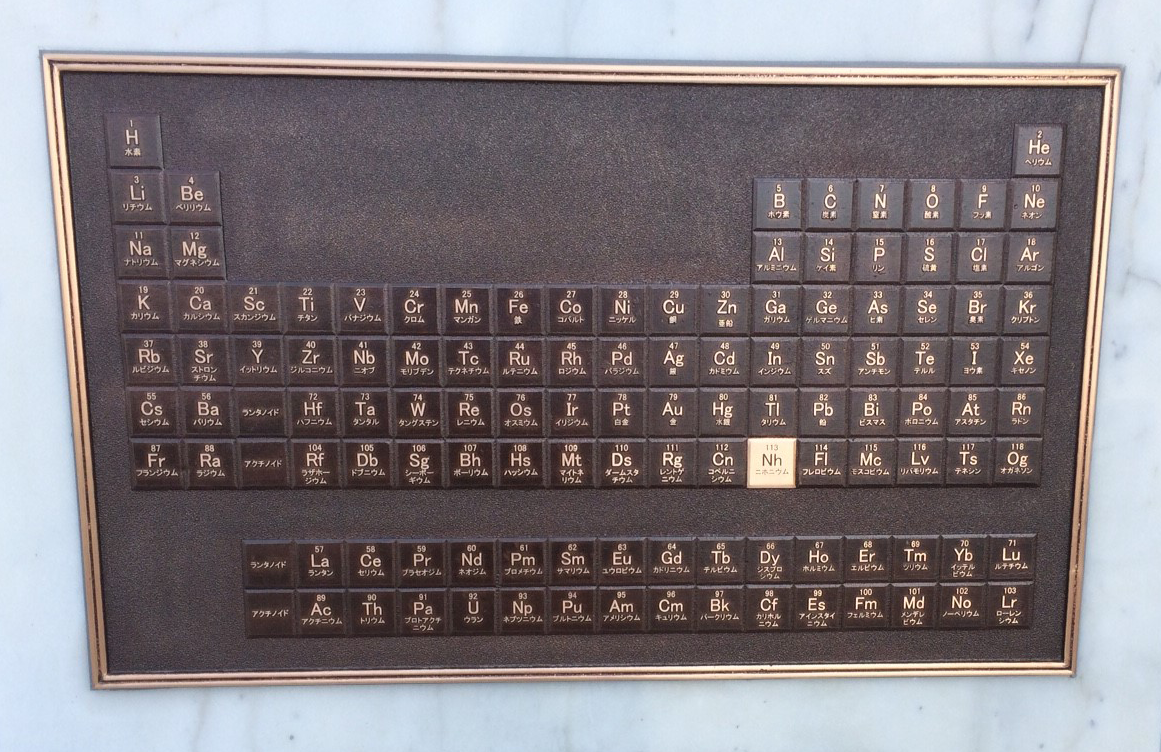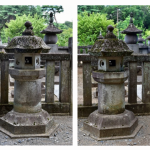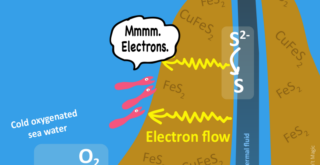We all know about the Hollywood Walk of Fame. Well, here in [itg-tooltip tooltip-content=”<p><strong>Wako City</strong><strong>: </strong>Wako-shi (和光市) is pronounced wakō (wah-ko-oo), not wāko (way-ko).</p>”]Wako City[/itg-tooltip], they’re making a similar, yet slightly more educational walkway. This new street is called Nihonium Dori in honor of the 113th element, which was discovered/created here in Wako City at the RIKEN Nishina Center for Accelerator-Based Science. The idea for the project came up during meetings between RIKEN and Wako City as a way to collaborate on celebrating Wako City’s 50th anniversary this year.

(top) The Supremes Star on the Hollywood Walk of Fame. (bottom) Zinc plaque in the Nihonium “walk of fame” Street.
When the project is complete, it will be a little more than half a mile. Like the Hollywood Stars, there will be a series of plaques encased in the sidewalk that represent each element of the periodic table, starting with the first element and going all the way to number 113. The bronze plaques are 30 × 30 cm, while the one for nihonium is planned to be a more impressive 120 × 120 cm. Thirty plaques have already been installed, so at the moment the series ends with zinc.
Coincidentally, zinc was one of the elements used in synthesizing nihonium. A city spokesperson explained that the budgetary outlays for the fiscal year only covered enough for the first 30 elements. He said that the remaining ones will be installed gradually, with the speed depending on how much the city is able to raise in donations for the project.
The street will also be lined with banners (there are currently eight near Wako City station), signposts (currently three), and a special monument at the right-hand turn adorned with an engraving of the periodic table, which highlights the newly names element (Nh) in special shade.
In addition to the informal name, the city was actually able to officially name part of the route “city route 113”, because streets in Japan are given numbers. The name “[itg-tooltip style=”text-decoration: overline underline; color: #2ea3f2; font-style: italic;” tooltip-content=”<p><strong>Nihonium Dori (ニホ二ウム通り)</strong>: The word nihonium (ニホ二ウム) is derived from Nihon — the Japanese word for Japan. Dori (通り) means street or road in Japanese.</p>”]Nihonium Dori[/itg-tooltip]” was chosen by local people in an online survey.
So what is so special about nihonium? Well first of all, it is the first chemical element discovered outside of Europe and the United States. Nihonium is also interesting from a scientific perspective because it lies within what is known as the “island of stability” (not the one from the Jimmy Carter speech). No element beyond lead in the periodic table has any stable isotope: every known variety of every known element from bismuth to nihonium (and beyond) undergoes radioactive decay at varying speeds. As you move up in atomic number, the rate of decay increases, and the elements become more radioactive.
But, a funny thing happens around element 110: successive elements are slightly more stable instead of less. (“Stable” is a relative term here, since these atoms still decay on time scales of seconds to microseconds.) The reason for this is that certain numbers of protons and neutrons are predicted to fill “shells” within the nucleus. If this sounds familiar, it’s because the principle is the same as what you might have learned about the [itg-tooltip tooltip-content=”<p><strong>noble gases: </strong><span style=&aquot;color: #666666; font-family: ‘Open Sans’, Arial, sans-serif; font-size: 14px;&aquot;>helium, neon, argon, krypton, xenon, and radon</span></p>”]noble gases[/itg-tooltip] in chemistry class. These elements are chemically inert because their electrons completely fill up the shells around their respective nuclei. These numbers of protons and neutrons are called “magic numbers”, and yes, that is the technical term.
So far, researchers have created nihonium with between 165 (nihonium-278) and 173 (nihonium-286) neutrons, and as the neutrons pile up, so does the stability: nihonium-278 has a half-life of just 0.24 milliseconds, while nihonium-286 has a half-life of nearly 20 seconds. Nuclear theory predicts that nihonium-287 would have a half-life of a whopping 20 minutes, and that this trend should continue all the way to nihonium-293, with 180 neutrons and 113 protons.
Actually producing nihonium-293 is no small challenge. It took the RIKEN team about a decade of bombardment to synthesize just three atoms of nihonium-278, the isotope they detected. If researchers ever do manage it, though, it will offer an experimental test for how correct our theories of nuclear forces are. While we think we know what will happen, there is always the chance that our models are incomplete. That might really be the more exciting outcome, since it would mean that there’s new science out there to discover! ?
[vifblike]
Don Warren, a very cool postoctoral researcher at the RIKEN Astrophysical Big Bang Laboratory contributed to this post.
We all know about the Hollywood Walk of Fame. Well, here in [itg-tooltip tooltip-content=”<p><strong>Wako City</strong><strong>: </strong>Wako-shi (和光市) is pronounced wakō (wah-ko-oo), not wāko (way-ko).</p>”]Wako City[/itg-tooltip], they’re making a similar, yet slightly more educational walkway. This new street is called Nihonium Dori in honor of the 113th element, which was discovered/created here in Wako City at the RIKEN Nishina Center for Accelerator-Based Science. The idea for the project came up during meetings between RIKEN and Wako City as a way to collaborate on celebrating Wako City’s 50th anniversary this year.

(top) The Supremes Star on the Hollywood Walk of Fame. (bottom) Zinc plaque in the Nihonium “walk of fame” Street.
When the project is complete, it will be a little more than half a mile. Like the Hollywood Stars, there will be a series of plaques encased in the sidewalk that represent each element of the periodic table, starting with the first element and going all the way to number 113. The bronze plaques are 30 × 30 cm, while the one for nihonium is planned to be a more impressive 120 × 120 cm. Thirty plaques have already been installed, so at the moment the series ends with zinc.
Coincidentally, zinc was one of the elements used in synthesizing nihonium. A city spokesperson explained that the budgetary outlays for the fiscal year only covered enough for the first 30 elements. He said that the remaining ones will be installed gradually, with the speed depending on how much the city is able to raise in donations for the project.
The street will also be lined with banners (there are currently eight near Wako City station), signposts (currently three), and a special monument at the right-hand turn adorned with an engraving of the periodic table, which highlights the newly names element (Nh) in special shade.
In addition to the informal name, the city was actually able to officially name part of the route “city route 113”, because streets in Japan are given numbers. The name “[itg-tooltip style=”text-decoration: overline underline; color: #2ea3f2; font-style: italic;” tooltip-content=”<p><strong>Nihonium Dori (ニホ二ウム通り)</strong>: The word nihonium (ニホ二ウム) is derived from Nihon — the Japanese word for Japan. Dori (通り) means street or road in Japanese.</p>”]Nihonium Dori[/itg-tooltip]” was chosen by local people in an online survey.
So what is so special about nihonium? Well first of all, it is the first chemical element discovered outside of Europe and the United States. Nihonium is also interesting from a scientific perspective because it lies within what is known as the “island of stability” (not the one from the Jimmy Carter speech). No element beyond lead in the periodic table has any stable isotope: every known variety of every known element from bismuth to nihonium (and beyond) undergoes radioactive decay at varying speeds. As you move up in atomic number, the rate of decay increases, and the elements become more radioactive.
But, a funny thing happens around element 110: successive elements are slightly more stable instead of less. (“Stable” is a relative term here, since these atoms still decay on time scales of seconds to microseconds.) The reason for this is that certain numbers of protons and neutrons are predicted to fill “shells” within the nucleus. If this sounds familiar, it’s because the principle is the same as what you might have learned about the [itg-tooltip tooltip-content=”<p><strong>noble gases: </strong><span style=&aquot;color: #666666; font-family: ‘Open Sans’, Arial, sans-serif; font-size: 14px;&aquot;>helium, neon, argon, krypton, xenon, and radon</span></p>”]noble gases[/itg-tooltip] in chemistry class. These elements are chemically inert because their electrons completely fill up the shells around their respective nuclei. These numbers of protons and neutrons are called “magic numbers”, and yes, that is the technical term.
So far, researchers have created nihonium with between 165 (nihonium-278) and 173 (nihonium-286) neutrons, and as the neutrons pile up, so does the stability: nihonium-278 has a half-life of just 0.24 milliseconds, while nihonium-286 has a half-life of nearly 20 seconds. Nuclear theory predicts that nihonium-287 would have a half-life of a whopping 20 minutes, and that this trend should continue all the way to nihonium-293, with 180 neutrons and 113 protons.
Actually producing nihonium-293 is no small challenge. It took the RIKEN team about a decade of bombardment to synthesize just three atoms of nihonium-278, the isotope they detected. If researchers ever do manage it, though, it will offer an experimental test for how correct our theories of nuclear forces are. While we think we know what will happen, there is always the chance that our models are incomplete. That might really be the more exciting outcome, since it would mean that there’s new science out there to discover! ?
[vifblike]
Don Warren, a very cool postoctoral researcher at the RIKEN Astrophysical Big Bang Laboratory contributed to this post.
Topics: ・chemistry・nuclear physics・










